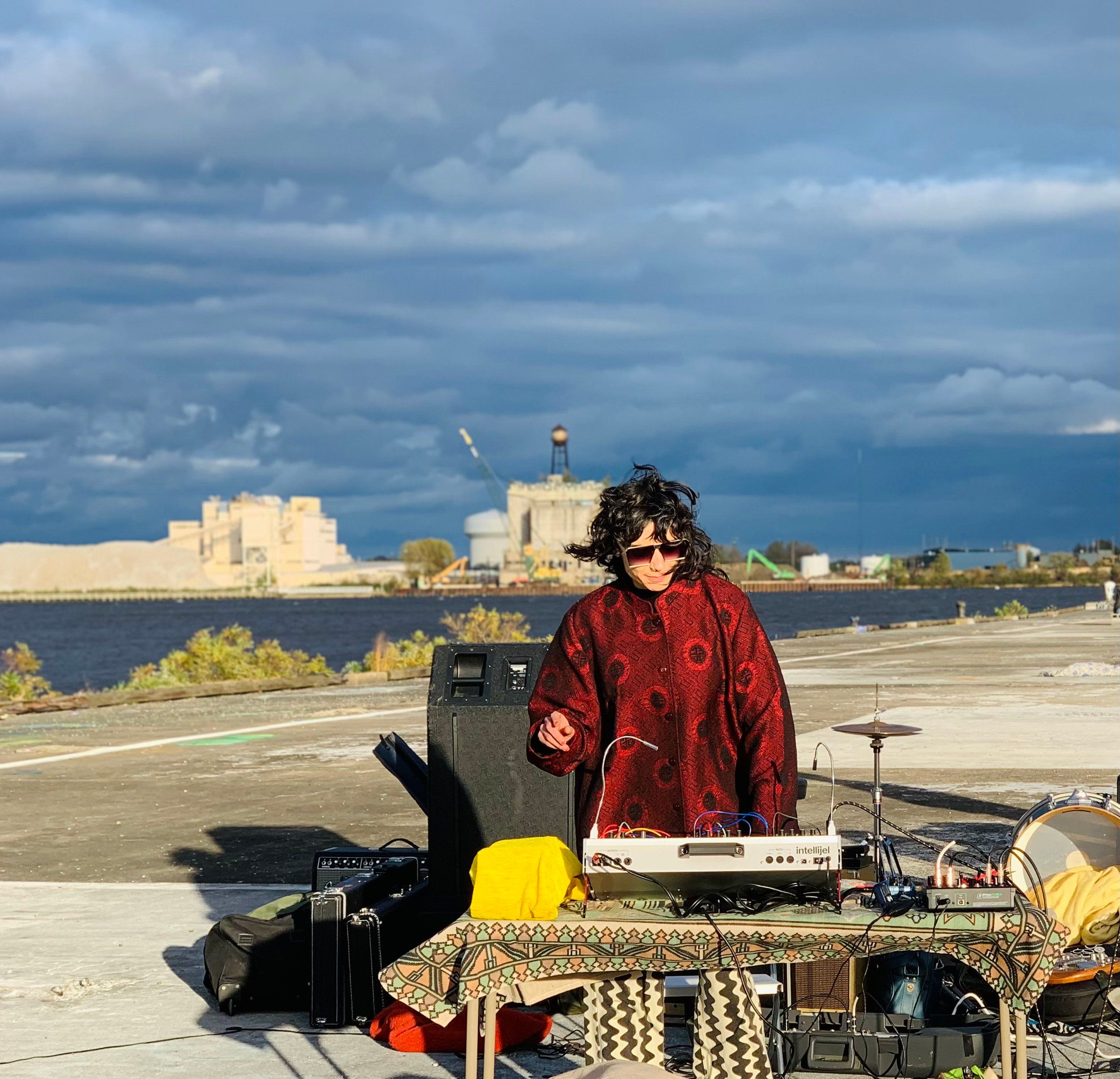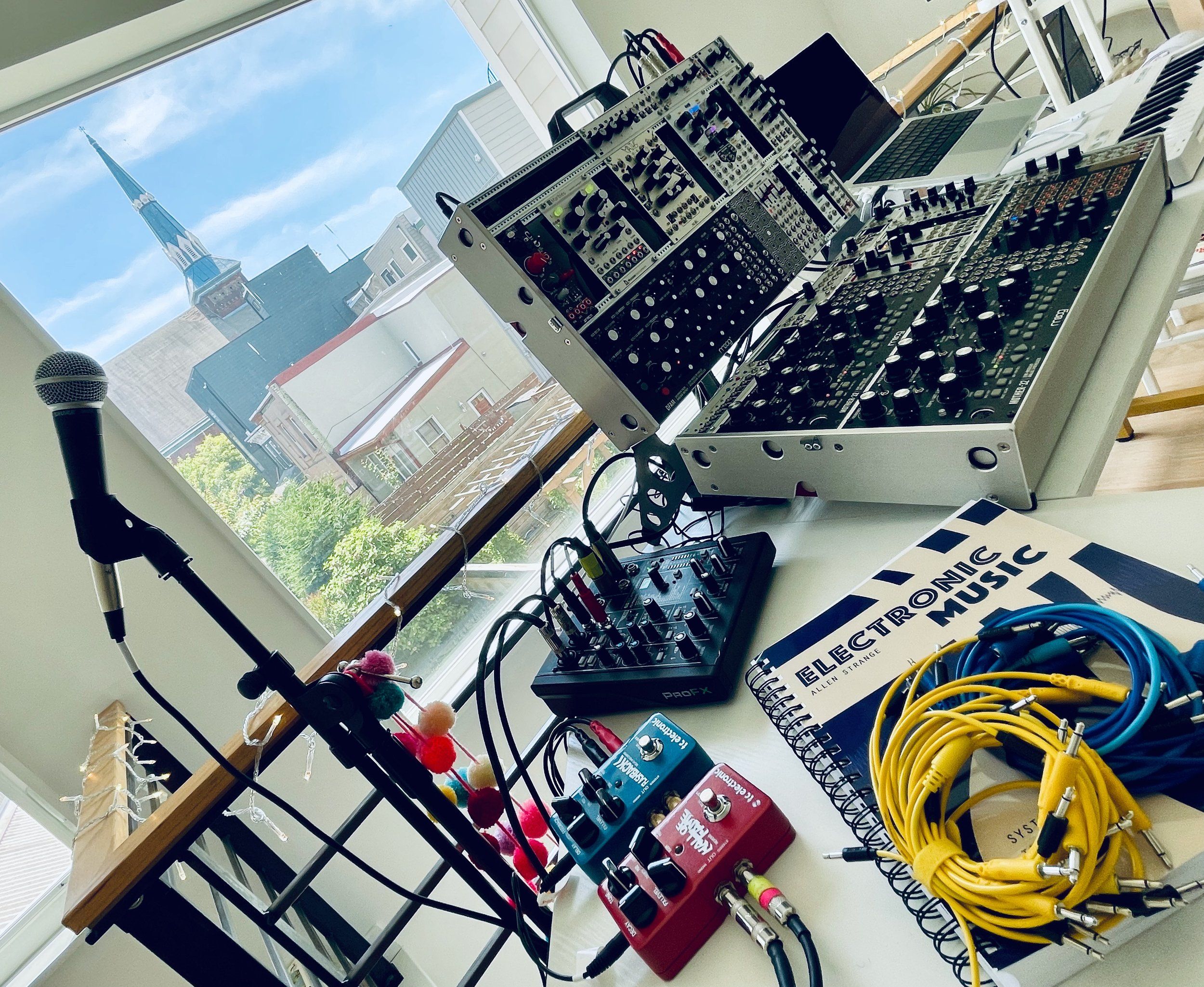
MANNA
Manna Pourrezaei aka MANNA is comfortable existing outside of expected forms, categories, and definitions. Coming off a year of intense long-form modular live performances at Great Circles’ Passages and Making Time, where MANNA joined a massive lineup with Julianna Barwick, Jamie XX, Mary Lattimore, and Laraaji, we are carried into a new year with “Joyful Participation in the Sorrows of Now”. Composed at home with a view overlooking St. Michael's Lutheran Church in Philadelphia’s East Kensington neighborhood, we feel somehow reassured while exploring unexpected aural architectures with MANNA at the helm.
Interview Conducted by Carolyn Zaldivar Snow aka Tangent Universes
Carolyn: Tell me about your background with synthesizers. I have seen you perform live with Modular on the Spot Philly and know a bit of your story. You have a preference for blending eurorack with two racked Moog Mother-32s in your case. Tell me how a medical student ends up with a house full of synths.
MANNA: Medicine wasn’t the right fit. The lifestyle was unsustainable. I realize now that the most difficult part of that experience was grieving music. All my time and mental space was spent on studying. There was no listening time and that wasn’t going to work for me.
My late start has meant a relative degree of freedom from preconceived notions of what music making should be, look like or sound like. As an experimental artist most interested in the avant-garde, it’s a precious thing to create without the need to unlearn or subvert traditional approaches to composition, songwriting and production.
And what is more playful and avant-garde than a modular synthesizer? A mutable, living instrument that is in constant conversation with the artist? They are unconventional and experimental by their very nature, both in form and function. I feel for those musicians whose expression is filtered and censured by the voice of past instructors/collaborators. I realize I am privileged to have found a drum instructor (Chris Powell, a dear friend, mentor and all-around amazing human) who within a month of lessons guided me away from a drum kit to a Roland TR-8S and finally to a Moog Mother-32 and the love of modular.
Moog’s Mother-32 semi-modular is the ideal synth for both beginners and advanced users. It’s voice, ability to remain in tune across octaves, the filter, the sequencer that’s also a keyboard, the patch bay, the midi in, the external input, the list continues.
I now use two Mother-32s that I’ve installed into a 7U x 104HP Intellijel performance case along with the DFAM. Racking the Moogs unlocks a whole new level of play. I enjoy connecting with one unit, one system, one organism. It’s far more flowy than having your semi-modulars live separately.
C: You're also a multimedia artist, how does the interplay of visual art intersect with your performances?
M: I love the ways in which modular synthesis and electronic music making delight my design brain. I’m a top-down information processor. I like to “see” the big picture for a deeper understanding. I consider all my live sets design work. Sound is the medium. The modular is the palette, with its breadth of voices, filters, envelopes, LFOS, clocks/gates and FX that together generate infinite possibilities. Time and Space are the canvas. To me a live set is really a sonic built environment. I’m constructing aural architecture.
C: For the uninitiated, tell us about Walmart beach, what is it? I feel like the MO of Philadelphia's modular scene is playing in abandoned and decommissioned spaces, like Velocities I in the abandoned chocolate factory where I saw you live for the first time. I remember your intro to your 20 minute piece was "just let the sounds do the talking." Do you want to tell us a bit about the crew and scene you developed your skills in?
M: I have infinite gratitude for the Modular on the Spot Philly community (Jerry Kaba, Chris Powell, Stefano Daddi, Eugene Lew). What a special group of humans. Their enthusiasm and love of modular provide a safe container to explore and experiment with what performing live as a solo artist using primarily eurorack might look, feel and sound like.
It was through MOTS Philly that I found myself supported by another incredible community of music lovers here in Philly: Great Circles. I owe a huge debt of gratitude to Justin Gibbon and the incredible group of humans who support the Great Circles (GC) cause. GC hosts an online radio show from their record shop that I highly recommend.
It’s also true that MOTS Philly prepared me for performing outside. My introduction into live performance began with outdoor sets. Controlling your sound without the containment of an architecture with its acoustics and reverb is a skill and an art.
Unconventional venues like Walmart Beach (a pier on Philly’s Delaware River waterfront that MOTS and other Philly musicians have used as a site for DIY shows) demand mindfulness and detachment. When the wind is howling on the water and it’s all expanse, you need to be fully present with your sound and mix. It’s a fantastic lesson in how to let the sounds do the talking.

C: Last summer you played the Making Time festival at Fort Mifflin among a group of established talents like Jamie XX and Mary Lattimore. What goes into preparing a live modular set, particularly set times with a longer time duration? I know you have played Philadelphia's Passages which is a 50 minute live solo set, any secrets to doing this?
M: Making Time ∞ Fort Mifflin 2023 was truly a transcendent futuristic sound experience. The lineup this year was unreal: Hailu Mergia, Laraaji, Marie Davidson, Pachyman, Kate NV. It was a gift to be included with such talent. What I love most about Making Time ∞ Fort Mifflin are the chill-out zones for those ambient party warriors like myself. Great Circles’ curation of this year’s chill-out zones was high level, the epitome of sonic sophistication. Performing in a colonial ammo bunker with four QRS speakers, two 5-foot amethyst geodes and divine visions by the Klip Collective was a special experience.
It was important to me that I honor that with a set that keeps the listener’s ear from beginning to end. 50 minutes and there’s no stopping between songs during a durational ambient set. You’re generating a vibe within a certain space over a given period of time. 50 minutes is a lot of time, a lot of content.
Usually, I see a set in terms of 3 movements, each with a distinct musical theme or phrase inspired by a particular patch or a certain set of voices and modules. Then there’s transitions and pace. Pacing is everything when you have 50 minutes to consider. Movement I is really a sonic onramp onto Movement II. The transition between Movement II & III is a chance for surprise that defies the listener’s expectations. Of course I try to maintain a certain level of cohesion throughout a set but I also hope to challenge the listener’s ideas of where the music “should” go.
C: Your track is titled “Joyful Participation in the Sorrows of Now” and takes us through a surprise array of timbral and tonal transitions. The track did not go where I think it was going, and I loved it. Tell me what was going through your head?
M: For that balance between fluidity and surprise, I tried to generate a diverse set of tones and timbres across the audiofield in sweeping, exaggerated and unexpected ways. I used the Wrong Sound Stage II Spatializer in many of the patches you hear and Moog’s Animoog Z app, a vector synthesis wavetable to direct the sounds and the listener’s attention. You’ll hear extreme panning for a similar end.

C: What are you listening to lately, who influences your music?
M: When working on “Joyful Participation in the Sorrows of Now”, I began most sessions deep listening Suzanne Ciani & Kaitlyn Aurelia Smith’s FRKWYS Vol. 13 collaboration, Sunergy. The warmth of that record was a creative lifeline when working through the darkness of winter. Two modular queens I very much admire for their sounds and unpretentious approach to music making combined and multiplied! Their sonic synergy is so modular. You have generative systems working on both the machine and human levels. That record IS synthesis. It blows my mind for endless reasons, reasons I’m still discovering with every listen. Just thinking about that record activates me, pulls me closer to my own instruments. It’s also a gorgeous example of the power of minimalism and maintaining space as a sonic, multi-dimensional dance floor for the sounds. I wanted to achieve my own version of that in “Joyful Participation in the Sorrows of Now”.
C: What is something you're doing to maintain joyful participation in the sorrows of now?
M: Commune with synths/music, experiment, play/dance and record with every moment I’m afforded. Making time to share in the joy of music with fellow lovers and the amazing community of weirdos I’ve found through MOTS Philly, Great Circles, and the magic of music. Play is so therapeutic. We know well the ways in which play influences/forms our relationship with the world, how we interact with it, how we frame and make sense of it. Play’s role in early development is well studied, the ways in which we use it to build our realities and identities is undeniable.
I do think it’s a great loss that we aren’t better encouraged to maintain a healthy and generative relationship with play throughout the lifespan. Play is necessary for all, just as sleep, diet, and movement are. The adults also need to play!
I do believe we can use play and music to build new worlds. When the sorrows of the world, the sorrows of now become so overwhelming that I feel compelled to disconnect, I connect with my synths as an opposite action. Patching and synthesis are exercises in full participation. Synthesizers are mindfulness tools. I sincerely believe that deep listening and attentive engagement improve observational skills, and empathy as a result. Synths ask that you slow down, that you treat witnessing and listening as the creative act. I can’t think of a more effective antidote to those technologies that pull us further from one another and ourselves.
C: Last question and I'll let you go-- you have one small suitcase to take to the Jersey Shore, what's in your weekend music and art bag?
M: Can I trade the small suitcase for one 7U x 104HP Intellijel performance case? What an intelligent design. I know you also use one. The ins/outs, power, handle, joiners, lid, soft case. The best gig case. I also love that company for their modules. They tend to offer a super intuitive interface. They’re simple, utilitarian and really know how to deliver the fundamental building blocks of synthesis.
Artist Playlist
We asked MANNA to send us what she’s listening to and inspired by in the form of a playlist which you can check out on Spotify below: